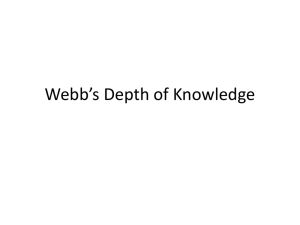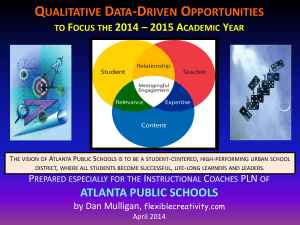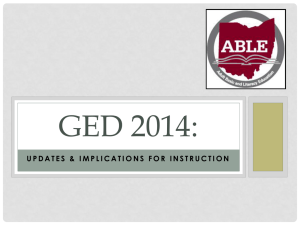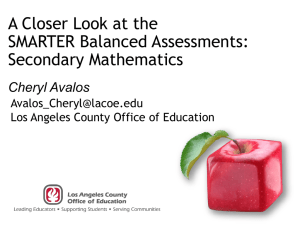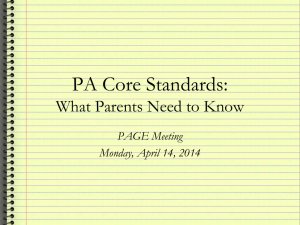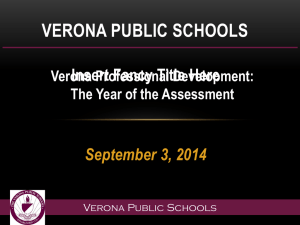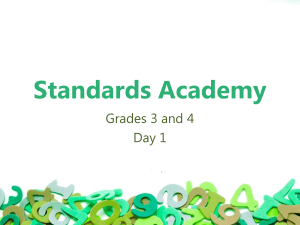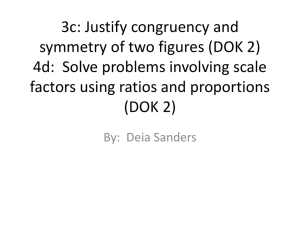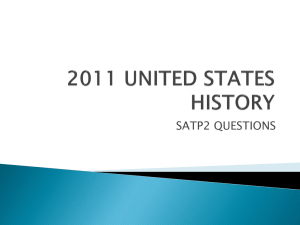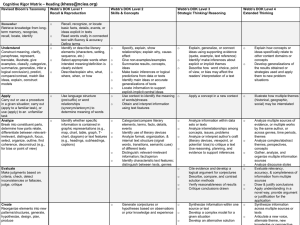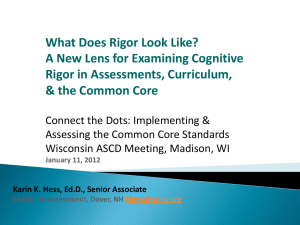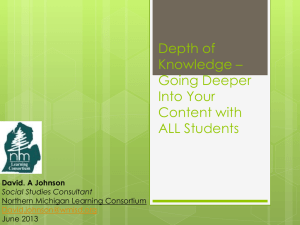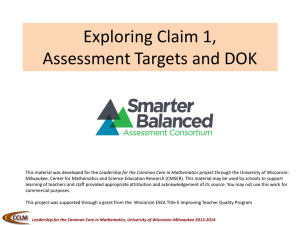DOK PowerPoint Grades 7-8
advertisement
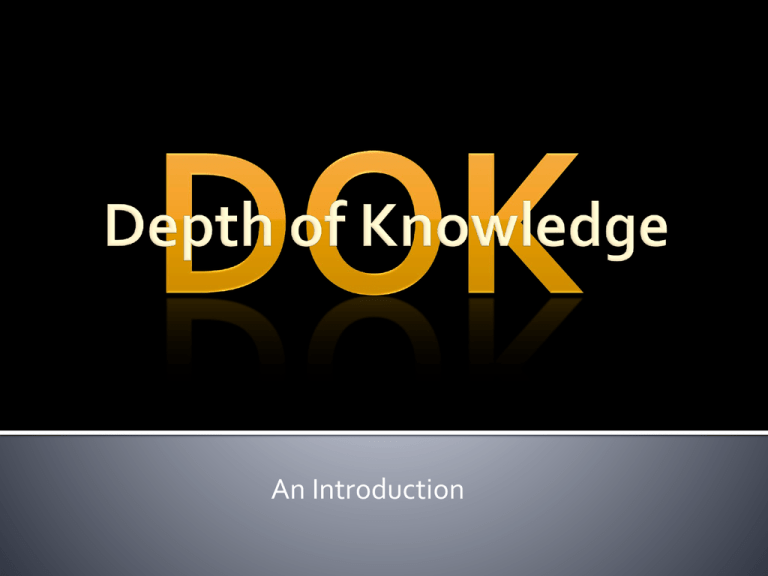
An Introduction “He who learns but does not think, is lost.” “He who thinks, but does not learn is in great danger.” • A scale of cognitive demand (thinking) to align standards with assessments • Based on the research of Norman Webb, University of Wisconsin Center for Education Research and the National Institute for Science Education • Defines the “ceiling” or highest DOK level for each Core Content standard for the state assessment • Guides item development for state assessments Webb’s Four Levels of Cognitive Complexity • Level 1: Recall and Reproduction • Level 2: Skills & Concepts • Level 3: Strategic Thinking • Level 4: Extended Thinking • Requires recall of information, such as a fact, definition, term, or performance of a simple process or procedure • Answering a Level 1 item can involve following a simple, well-known procedure or formula Examples: • List animals that survive by eating other animals • Locate or recall facts found in text • Describe physical features of places • Determine the perimeter or area of rectangles given a drawing or labels • Identify elements of music using music terminology • Identify basic rules for participating in simple games and activities • Includes the engagement of some mental processing beyond recalling or reproducing response • Items require students to make some decisions as to how to approach the question or problem • Actions imply more than one mental or cognitive process/step Examples: •Compare desert and tropical environments • Identify and summarize the major events, problems, solutions, conflicts in literary text • Explain the cause-effect of historical events • Predict a logical outcome based on information in a reading selection • Explain how good work habits are important at home, school, and on the job • Classify plane and three dimensional figures • Describe various styles of music • Requires deep understanding exhibited through planning, using evidence, and more demanding cognitive reasoning • The cognitive demands are complex and abstract • An assessment item that has more than one possible answer and requires students to justify the response would most likely be a Level 3 Examples: •Compare consumer actions and analyze how these actions impact the environment • Analyze or evaluate the effectiveness of literary elements (e.g., characterization, setting, point of view, conflict and resolution, plot structures) • Solve a multiple-step problem and provide support with a mathematical explanation that justifies the answer • Requires high cognitive demand and is very complex • Students are expected to make connections, relate ideas within the content or among content areas, and select or devise one approach among many alternatives on how the situation can be solved • Due to the complexity of cognitive demand, DOK 4 often requires an extended period of time Examples: •Gather, analyze, organize, and interpret information from multiple (print and non print) sources to draft a reasoned report • Analyzing author’s craft (e.g., style, bias, literary techniques, point of view) • Create an exercise plan applying the “FITT (Frequency, Intensity, Time, Type) Principle” The Depth of Knowledge is NOT determined by the verb (Bloom’s Taxonomy), but by the context in which the verb is used and the depth of thinking required. • Words like explain or analyze have to be considered in context. • “Explain to me where you live” does not raise the DOK of a simple rote response. • Even if the student has to use addresses or landmarks, the student is doing nothing more than recalling and reciting. DOK 1- Describe three characteristics of metamorphic rocks. (Requires simple recall) DOK 2- Describe the difference between metamorphic and igneous rocks. (Requires cognitive processing to determine the differences in the two rock types) DOK 3- Describe a model that you might use to represent the relationships that exist within the rock cycle. (Requires deep understanding of rock cycle and a determination of how best to represent it) DOK is a reference to the complexity of mental processing that must occur to answer a question, perform a task, or generate a product. • Adding is a mental process. • Knowing the rule for adding is the intended outcome that influences the DOK. • Once someone learns the “rule” of how to add, 4 + 4 is DOK 1 and is also easy. • Adding 4,678,895 + 9,578,885 is still a DOK 1 but may be more “difficult.” Different states, schools, and teachers may use different models to describe cognitive rigor. Each may address something different. Bloom- What type of thinking (verbs) is needed to complete a task? Webb- How deeply do you have to understand the content to successfully interact with it? How complex or abstract is the content? Hess- Applies Webb’s DOK to Bloom’s cognitive process dimensions (Cognitive Rigor Matrix) BLOOM WEBB Understanding DOK Activity 7% of the ELA CCSS Standards max out at Level 1 12% of the ELA CCSS Standards max out at Level 2 55% of the ELA CCSS Standards max out at Level 3 25% of the ELA CCSS Standards max out at Level 4 DOK chart- U:\CIA-CURRICULUM INSTRUCTION ASSESSMENT\Instructional Support Specialists\WebbsDOK.pdf Content specific cognitive rigor matrices: Reading/Writing- U:\CIA-CURRICULUM INSTRUCTION ASSESSMENT\Instructional Support Specialists\CognitiveRigorMatrixReadingWriting.doc Math/Sci - U:\CIA-CURRICULUM INSTRUCTION ASSESSMENT\Instructional Support Specialists\CognitiveRigorMatrixMathScience.doc Applying Webb’s DOK: Writing- U:\CIA-CURRICULUM INSTRUCTION ASSESSMENT\Instructional Support Specialists\applying the DOK_Writing.pdf Reading- U:\CIA-CURRICULUM INSTRUCTION ASSESSMENT\Instructional Support Specialists\applying the DOK_Reading.pdf Math- U:\CIA-CURRICULUM INSTRUCTION ASSESSMENT\Instructional Support Specialists\applying the DOK_Math.pdf Science- U:\CIA-CURRICULUM INSTRUCTION ASSESSMENT\Instructional Support Specialists\applying the DOK_Sci.pdf Social Studies- U:\CIA-CURRICULUM INSTRUCTION ASSESSMENT\Instructional Support Specialists\applying the DOK_SS.pdf “What exactly do “fewer, clearer, and higher standards” really look like in the classroom? Using a cognitive rigor matrix to analyze curriculum, plan lessons, and implement assessments” (article)- U:\CIACURRICULUM INSTRUCTION ASSESSMENT\Instructional Support Specialists\HessArticle.pdf ** Hyperlinks connected to U: drive The Bottom Line… LA County Office of Educationhttp://www.lacoe.edu/ NYC Department of Educationhttp://schools.nyc.gov/default.htm Karen Hess Presentation http://www.nciea.org/publications/rigorprese ntation_KH11.pdf

